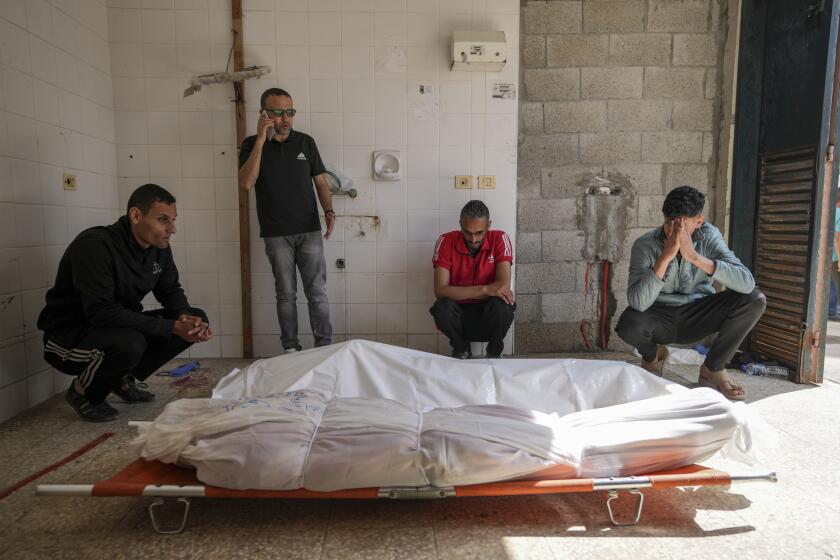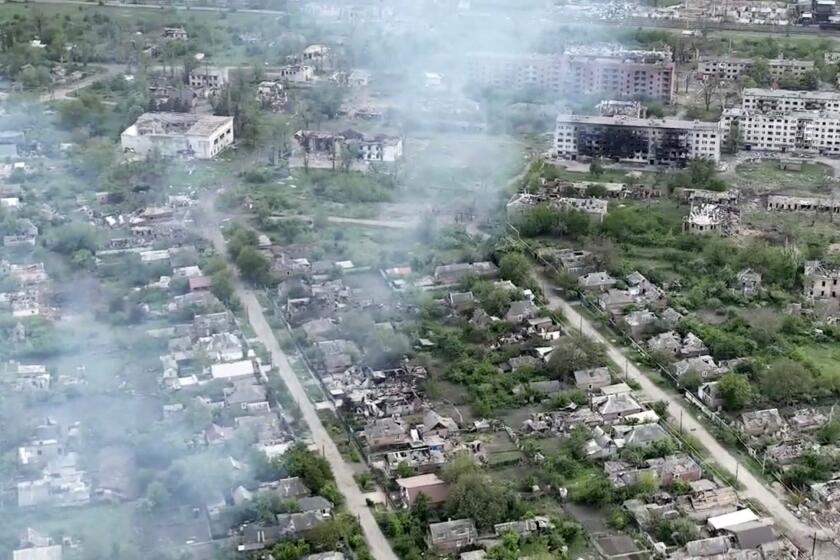Rainy season threatens earthquake-battered Haiti
Every afternoon the clouds pile up on the high ridges above this collapsed city and the breeze descends with a telltale earthy smell. The rain usually waits until dark, when short but spectacular bursts deluge random bits of the capital and unleash torrents of rock and gray mud.
The rainy season is bearing down, and Haiti is not ready.
Three months after the earthquake killed more than 200,000 people, more than 2.1 million Haitians are still living in tents and under tarps, many on dangerous hillsides and tidal flats.
Ernst Y’Voyelle, 38, studies those clouds warily from his hut clinging to the edge of a ravine in a hillside tent camp where as many as 50,000 people live.
“There’s going to be a lot of people buried here,” he said.
A short rain the night before had turned his patch of loose dirt into a sticky slop. Half an inch of clay clung to his loafers.
Aid workers had been talking about moving people out of dangerous spots like this one for weeks, but only last weekend did they begin, with 62 people.
Y’Voyelle was not one of them.
Nor was Saluido Desauguste. He was sleeping the other night when water poured out from a drainage ditch near his tent. He had time only to get himself and his two children out before the water swept away the tent and all the possessions he had left after the earthquake took everything else.
A tall man with ropy muscles, he dug through the muck the next morning looking for anything that might be salvaged. He found only his little girl’s purple sandal.
Certainly much has been done in Haiti. The bodies in the streets were buried. Residents in Port-au-Prince have more access to medical care than they have had in decades. Aid groups are still distributing food and water. And although fallen buildings remain in stratified heaps of concrete and great knots of rebar, excavators are picking away at them, clearing out clogged drainage canals and shoring up low areas prone to flooding.
But everyone agrees that the next steps require a coordinated plan to get people into safer camps and, ultimately, housing. Humanitarian groups and the government have been talking about this since a few days after the quake, and set a target date of April 15 to relocate those in the most danger. That deadline has come and gone.
There is a feeling that the temporary is settling into the permanent. Tin and wood are slowly transforming tent camps into shantytowns, and trails are emerging on the heaps of shattered concrete as if they were part of the natural topography.
Claire Basiler, 80, still can’t go beyond the 4-foot-wide alley behind her home on Rue Champs Mars downtown because she is too feeble to climb over 20 feet of rubble.
“I haven’t left once since the earthquake,” she said.
She complained that the rainwater has no way to get out either, so people have to carry it out with buckets. Mosquitoes are breeding and malaria is a growing concern.
Her neighbor Lefils Rochene, 57, can walk out, but his livelihood is trapped there. He used to sell furniture in his storefront business across the street. The earthquake destroyed the store, but spared his storage room on the alley. Several days ago he dragged an antique sofa, two old wing chairs and some office chairs onto the ruins of the Hotel Air Fresh.
“I’m just displaying it so people will know I’m still here,” he said.
But few are shopping. Many middle-class people who once could afford such things are living in tent camps.
In a sprawling camp on the Petionville Club golf course, engineers have identified 7,500 people to be moved immediately. By Friday, 1,629 had been relocated.
That camp is getting far more attention than any of the more than 1,300 others in Haiti -- its manager is the actor Sean Penn, who co-founded a relief organization doing work in the country. Work crews are scrambling to shore up a hillside with sandbags and dig drainage.
Nearby in a lush canyon called La Vallee de Bourdon on a recent day, no one was scrambling to help the residents of a fallen shantytown. After the quake, residents simply moved to open land next door. They cut trees and brush, dug shelves in an escarpment and used the sticks they gathered to hold up tarps. Some are on the edge of a cliff; some are on a dry river bottom.
The International Organization of Migration says 8,000 people live in this valley, 2,500 of them in danger.
But in this particular bend of the river, the only one pushing them to get out was the landowner.
“I come every day to give them pressure,” he said. He declined to give his name, but the people there call him Fabrino. “It’s been three months. Now it’s time to go.”
Yeye Luiso, 29, had nowhere to go but to another hillside in the canyon. He didn’t understand why the landowner couldn’t wait.
“He’s threatening that he’s going to come with a staff of people to beat us up and tear down our houses and force us out,” he said.
Officials, who say they will begin moving people out of danger in the canyon this weekend, give many reasons why the effort to relocate people is only starting. They cite the immensity of the task, and the difficulties of coordinating among hundreds of aid groups and a government that lost nearly all of its institutions.
“It’s like starting from minus zero,” said George Ola-Davies, a spokesman for the U.N. peacekeeping mission.
Relocation is also difficult culturally. Haitians rely on their communities to survive. They borrow money from neighbors, share food, watch one another’s children, sell things they pick up in the central markets.
The camp where residents of the Petionville Club are being moved is on a dust-blown, desolate slope far from the city, where people will be wholly reliant on aid.
Brizard Brigarde, 59, plans to hold out on the golf course. His family of six lives with four other families in a cluster of sweltering rooms made of orange tarps that cast an almost hellish glow.
He cradles his fussy baby girl, Taicha, who was just 2 weeks old when the earthquake hit and their house came down on top of her. Somehow she fell into a crevice and was pulled out with a smile.
Brigarde is a tailor. He started building his home in 1973, and by the day of the earthquake it had three stories, a television, running water, a dining room set -- all the accouterments of the middle class.
Now, he has what fits in a tent. The baby falls asleep in his arms, and he lays her down on a pillow in a laundry bucket.
More to Read
Start your day right
Sign up for Essential California for news, features and recommendations from the L.A. Times and beyond in your inbox six days a week.
You may occasionally receive promotional content from the Los Angeles Times.






